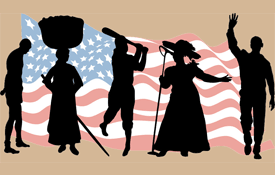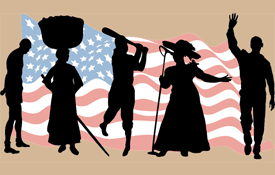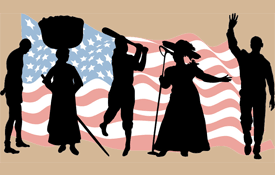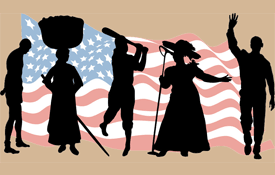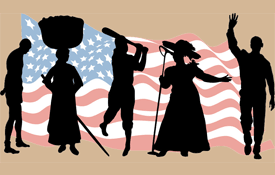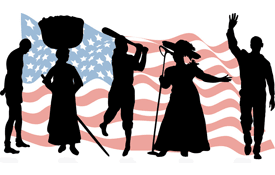Categories
-
- Inventors
- by Hugh Smith
- 10/30/2013
Garrett Morgan invented the gas mask in 1912, (U.S. patent 1,113,675 issued in 1914). His mask was used during World War I to protect soldiers from chlorine gas fumes. Morgan lived in Cleveland, Ohio when he was granted U.S. patent # 1,475,024 on November 20, 1923 for the three-way traffic signal. He patented a three-armed signal mounted on a T-shaped pole that indicated "stop" and "go" for traffic in two directions. Morgan also had another signal for stopping traffic in all directions before the stop and go signals changed. This is similar to today's yellow light. General Electric bought Morgan's patent for $40,000, and his traffic management device was used throughout North America until it was replaced by the red, yellow and green-light traffic signals currently used around the world. Discover more about other African American inventors.
-
0 The Lost History of African American Inventors
- Inventors
- by Hugh Smith
- 04/25/2012
Basketball legend and now author Kareem Abdul-Jabbar reveals an assortment of creative personalities in his book What Color Is My World?: The Lost History of African-American Inventors. Discover them in Kareem Abdul-Jabbar Children's Book Highlights Black Achievement from a Black Voices article.
-
0 10 Top Technologies Created by Ingenious Black Inventors
- Inventors
- by Hugh Smith
- 02/06/2008
Here are 10 top technologies created by important black inventors. We salute them all during black history month. 1) Fire extinguisher (aero-foam) - Dr. Percy L. Jullian Dr. Percy L. Julian, (1899-1975), elevated the quality of American life with many discoveries through his research in chemistry. Dr. Julian earned his Masters Degree at Harvard in 1923, and his Ph.D. at the University of Vienna in 1931. During World War II, from a soybean protein, he developed a life saving, fire-fighting foam used by the U.S. Army and Navy. His resulting fire extinguisher was used to put out gas and oil fires. Dr. Julian also developed low cost cortisone to treat arthritis. He developed drugs to treat rheumatic fever, and glaucoma. 2) Electric lampbulb - Lewis Latimer New York City native Lewis H. Latimer, (1848-1928), invented and patented the first electric light bulb with a carbon filament (March 21, 1882). He joined the Thomas A. Edison Company in 1886. Edison later developed the carbon filament into the modern light bulb. Latimer is credited with publishing the first electric lighting system textbook. 3) Lantern - Michael C. Harney Michael C. Harney made significant improvements to wicks, and was granted a patent for a lantern/lamp on August 19, 1884. The St. Louis, Missouri resident created a wick raising device to improve the efficiency of the lantern. 4) traffic light - Garrett Morgan Garrett Morgan lived in Cleveland, Ohio when he was granted U.S. patent # 1,475,024 on November 20, 1923 for the three-way traffic signal. He patented a three-armed signal mounted on a T-shaped pole that indicated "stop" and "go" for traffic in two directions. Morgan also had another signal for stopping traffic in all directions before the stop and go signals changed. This is similar to today's yellow light. General Electric bought Morgan's patent for $40,000, and his traffic management device was used throughout North America until it was replaced by the red, yellow and green-light traffic signals currently used around the world. 5) Gas mask - Garrett Morgan Garrett Morgan also invented the gas mask a decade earlier in 1912, (U.S. patent 1,113,675 issued in 1914). His mask was used during World War I to protect soldiers from chlorine gas fumes. 6) Automatic gear shift - Richard Bowie Spikes On December 6, 1932, Richard Bowie Spikes received patent # 1,889,814 for an automatic gear shift which improved transmission design in cars. 7) Gamma-electric cell - Henry T. Sampson Henry T. Sampson, of El Segundo, California, along with Dr. George H. Miley received United States Patent # 3,591,860 on July 6, 1971, for using a gamma-electric cell for producing a high-output voltage from a source of radiation. 8) Air conditioning unit - Frederick McKinley Jones Frederick McKinley Jones of Minneapolis, Minnesota received several U.S. patents for air conditioning technology. This particular patent, # 2,336,735, granted December 14, 1943, was given for a compact and removable portable cooling unit that could easily be placed at the top of compartments on trucks and in railroad cars. 9) Thermostat control - Frederick McKinley Jones Jones won another patent on February 23, 1960, for a thermostat that could regulate refrigeration. 10) Paints, stains, and cosmetic creams - George Washington Carver George Washington Carver (1864-1943) was born in Missouri in the closing days of the Civil War. He rose from slavery to become the first nationally known African American scientist. In 1896, Booker T. Washington selected the then young graduate student Carver, (who at the time was the only black American with advanced training in scientific agriculture), to head the newly created agricultural department at Tuskegee Institute. Dr. Carver remained at Tuskegee for nearly 50 years. His research work with various fruits, vegetables, and legumes, most notably the peanut, commanded international attention. On January 6, 1925, Dr. Carver was granted U.S. patent # 1,522,176 for a process that produces a cosmetic cream made from peanuts. Carver describes his creation in the patent as a "vanishing cream of any desired or usual tint." Two years later on June 14, 1927, Carver received U.S. patent # 1,632,365 for the process of producing paints and stains from clays. His plan was to use clays of different colors found in different parts of the USA combined with his patented process "for treating wood or other materials."
-
0 Granville T. Woods Tightens up Technology
- Inventors
- by Hugh Smith
- 05/09/2006
On May 5, 2006, Inventor Granville T. Woods was inducted into the National Inventors Hall of Fame in Akron, Ohio. The Inventors Hall of Fame was established in 1973 by the National Council of Patent Law Associations, now the National Council of Intellectual Property Law Associations, and the Patent and Trademark Office of the U.S. Department of Commerce. Columbus, Ohio native Woods invented the railroad telegraph in the late 19th century, making it possible for moving trains to communicate with other trains and with stations. A genius with little formal education, and a machinist early in his career, Granville developed: telephone technology battery technology steam boiler technology 3rd rail technology (used by electric trains today) Why does it take so long for black history people to be formally recognized for incredible contributions? One reason, tied to discrimination, is because like Lewis H. Latimer and others, Woods was not able to benefit from his intellectual property. Granville Woods signed away most of his patent rights, so when he passed away in 1910, he had little money to show for his great inventions. Thank you National Inventors Hall of Fame, for inducting one of America's great inventors, Granville T. Woods.
-
0 19th Century Wonder Woman in the Patent House
- Inventors
- by Hugh Smith
- 04/10/2006
When it comes to roll call time for inventors, guys generally get all the credit. Creativity has no gender boundary, so here's a quick salute to the first African American woman to receive a U.S. patent, way back in 1885. On July 14, 1885, a Chicago furniture storeowner received patent number 322,177 for a clever convertible bed design. Her cabinet bed was literally a bed in a box. The intricate mechanical folding enclosure looked more like an antique desk in disguise. Popping open the top of the cabinet revealed a two-winged apparatus below, identical halves of the bed, made to balance on the cabinet's sturdy center of gravity providing a restful platform for sleep. Sarah Goode had the intuition, the wisdom, and the smarts to dream up this masterpiece.
-
0 Edison, Latimer, Dickinson - Fathers of Invention
- Inventors
- by Hugh Smith
- 03/20/2006
In the world of black history people, there are many unique personalities. Master organ designer Joseph Dickinson is one of them. In the late 19th century, Dickinson won numerous awards for his organs, but he didn't stop there. Expanding on his technical knowledge of musical instruments, Dickinson won several patents for the player piano. His company perfected a system of controlling the volume of mechanical musical instruments, as well as proudly obtaining a number of phonograph patents...which leads us to Thomas Edison. Thomas Edison didn't invent all of those magical devices he's given credit for by himself. The phonograph? Yes, Edison gets the credit, but he had several bright and energetic understudies who made important contributions to his research and ultimate patents. Lewis H. Latimer, (1848-1928), invented and patented the first electric light bulb with a carbon filament (1882). He joined the Thomas A. Edison Company in 1886 to become the only black engineer on Edison's staff. Edison later developed the carbon filament into the modern light bulb.
